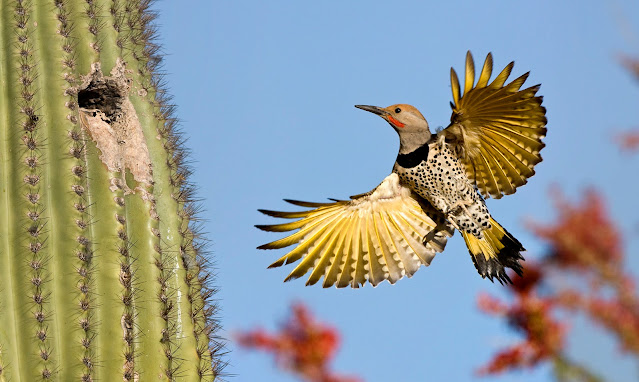The Mystery of the Golden Flicker and the Saguaro Cactus
 |
| Gilded Flicker and its saguaro nest cavity, Bruce Taubert |
Forty years ago, my wife and I were driving along the road through Comababi Pass on the Tohono O’odham Nation. In that landscape, seemingly otherwise untouched by human hands, we kept passing saguaros that had been … beheaded.
To me the only plausible explanation must be someone had pulled up to each giant cactus, erected a ladder, and gone up with a chainsaw to cut the top eight feet off of Arizona’s state cactus: a felony.
 |
| Photos by Michael McNulty |
That same evening, we ran into Ray Turner, the legendary biogeographer and lifelong employee of the U.S.G.S. I explained to him my alarm at what was happening in the saguaro forest, and he patiently (and, I have to say, very politely) explained that what we had seen were the impacts of nest building by Gilded Flickers.
That saguaros are excavated for bird nests is not a secret. Flickers and especially the much more numerous Gila Woodpeckers rely heavily on saguaros to build their homes. After the birds that build these nests abandon them, the holes are taken up by other species including Elf Owl, American Kestrel, Ash-throated and Brown-crested Flycatchers, Purple Martin, and Western Screech-Owl.
 To appreciate the role of saguaros in the lives of these birds, ponder the 38’ high woodpecker condominium at right. It has more than ninety cavities. Many of them were woodpecker apartments. It is not possible to exaggerate the significance of the saguaro for bird habitat.
To appreciate the role of saguaros in the lives of these birds, ponder the 38’ high woodpecker condominium at right. It has more than ninety cavities. Many of them were woodpecker apartments. It is not possible to exaggerate the significance of the saguaro for bird habitat.
Saguaros are able to stand thirty to fifty feet tall because of the woody structural support inside of them we call “ribs.” On average, flickers nest between six and ten feet down from the tip of the cactus. And Gila Woodpeckers don’t chop down the tops of saguaros? They don’t. While innumerable Gilas nest in cavities, their excavations rarely cut through the wooden ribs. Rather, as soon as they create an entrance, they drill straight down to create a cavity in between the ribs and the exterior skin of the cactus.
The relation between saguaros and Gilded Flickers presents a more complicated story. It’s necessary to understand that flickers favor the very tallest saguaros. It is thought that such a high perch allows the flickers to both survey the sky for aerial predators and escape ambush by snakes and rodents on the ground that would otherwise invade their nests.
As the saguaro reaches ever skyward, its woody ribs become quite attenuated. Five or ten feet from the top of a tall saguaro, the ribs are no thicker than one of your fingers, and the diameter of the saguaro is thinner at that point as well. When a Gilded Flicker starts hammering a cavity into the saguaro at that height, it needs to occupy the great majority of the interior circumference of the cactus. In doing so, it cuts through the ribs entirely. In very short order the saguaro heals the wound with a bark-like glue that seals the wound and prevents bacteria and fungus from reaching the softer cell tissue beneath, a seal that will last far longer than the living tissue of the cactus.
Consequently, when the saguaro finally keels over, and its living tissue degrades back into the earth, the wooden ribs and the bird cavities will still be lying on the desert floor. In local parlance, these structures created by the healing of wounds, and the former homes of woodpeckers, are called saguaro ‘boots.’ Here is the nest/boot of a Gilded Flicker, below, created by the secretions of a saguaro.
In time, after a flicker has fully excavated a cavern near the top of the cactus, it becomes unstable. Devoid of supportive woody stems, the top begins to lean and collapse, see below. Eventually, it may topple off and the elegant line of the saguaro’s trunk becomes truncated. Some percentage of saguaros that are the subject of this treatment succumb, because the wound has allowed pathogens to enter the plants’ ‘bloodstream.’
But even more mysterious is the ultimate effect of all this avian construction on the saguaro forest. I’ve come to believe that there are mutual benefits, and saguaros aren’t losers in this penthouse-building scheme. If you cut off the top of a saguaro, and more arms grow up from beneath, the more opportunities other flickers will have at a later date to construct their chambers. Most importantly, the multiplication of stems on these additional arms generates an undeniable expansion in the saguaro’s ability to flower, fruit, and set seed in years of adequate resources. More seed, more saguaros. More saguaros, more flickers. Coevolution in action!
Purists may resist a suggestion that flickers are intentionally bringing down saguaro tops in order to grow more flicker real estate. Still, I’m pretty sure that those people do not know what a flicker’s intention is any more than I do. Like you and me, they’re acting in their own best interests, and after thousands of years it would not be at all surprising to find that the practice has been calibrated in such a way that saguaros are benefited too.
Michael McNulty was born in Tucson, is a 3rd generation Arizona native, grew up in Bisbee, spent his working career as a water rights lawyer, and now is completely committed to curiosity and wonder.




Comments
Post a Comment
Thanks, we value your opinions! Your comment will be reviewed before being published.